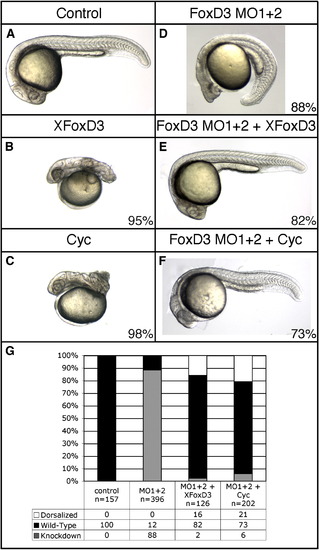Fig. S2
|
Rescue of Foxd3 knockdown by Xenopus foxd3 or cyclops. At the one-cell stage, wild-type embryos were injected with a mixture of foxd3MO1 and foxd3MO2 (MO1 + 2, total dosage 20 ng) alone (D), or in combination with 30 pg of Xenopus foxd3 (XFoxD3) (E) or 20 pg of cyclops (Cyc) (F) mRNA, and axial development was assessed at 24 hpf (A–F). Embryos were phenotypically classified as knockdown (D), wild-type (E, F) or dorsalized (not shown), and these classes are quantified in (G). Knockdown embryos have reduced head structures, reduction of trunk mesoderm, and expanded tail somites (D), while rescued embryos are normal (E) or near normal (F) in all aspects of axis formation. Injection of MO1 + 2 alone resulted in 88% (n = 396) of embryos with the knockdown phenotype, while 82% (n = 126) of Xfoxd3-injected and 73% (n = 202) of cyclops-injected embryos were phenotypically wild-type. A minority of knockdown embryos rescued by injection of Xfoxd3 (16%) or cyclops (21%) mRNA displayed a dorsalized body axis. Injection of Xfoxd3 or cyclops mRNA alone strongly dorsalized control embryos (B, C). Shown are lateral views, anterior left, of live embryos. |
Reprinted from Developmental Biology, 342(1), Chang, L.L., and Kessler, D.S., Foxd3 is an Essential Nodal-Dependent Regulator of Zebrafish Dorsal Mesoderm Development, 39-50, Copyright (2010) with permission from Elsevier. Full text @ Dev. Biol.

